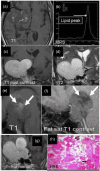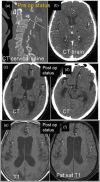Fat in the brain: Facts and features
- PMID: 36609194
- PMCID: PMC11444328
- DOI: 10.1177/19714009221150848
Fat in the brain: Facts and features
Abstract
The presence of fat within a lesion in the brain is not only easy to identify on both CT/MRI but also can help narrow the differential. The purpose of this paper is to illustrate the spectrum of common and rare fat-containing lesions in the brain that are encountered in clinical practice. This paper intends to discuss 15 such lesions which are confirmed by MRI findings and histopathological correlation. We divided the spectrum of fat-containing lesions into lesions with adipose cells, lesions with cholesterol-rich content and tumours with lipomatous differentiation/transformation. Knowledge of these common and rare fat-containing lesions is essential for making the right diagnosis or narrowing the differential diagnosis.
Keywords: CT; Fat; MRI; MRS; adipose; brain; cholesterol; lipid.
Conflict of interest statement
Declaration of conflicting interestsThe author(s) declared no potential conflicts of interest with respect to the research, authorship, and/or publication of this article.
Figures

















References
-
- Buyukkaya R, Buyukkaya A, Ozturk B, et al. CT and MR imaging characteristics of intravestibular and cerebellopontine angle lipoma. Iran J Radiol [Internet] 2014; 11(2). [cited 2022 Nov 28]. Available from https://brief.land/iranjradiol/articles/17946.html - PMC - PubMed
-
- Yildiz H, Hakyemez B, Koroglu M, et al. Intracranial lipomas: importance of localization. Neuroradiology 2006; 48(1): 1–7. - PubMed
-
- Taglialatela G, Galasso R, Conforti R, et al. Lipoma of corpus callosum: case report and literature review. Riv Ital Neurobiol 2008; 54: 221–227.
Publication types
MeSH terms
LinkOut - more resources
Full Text Sources
Medical

